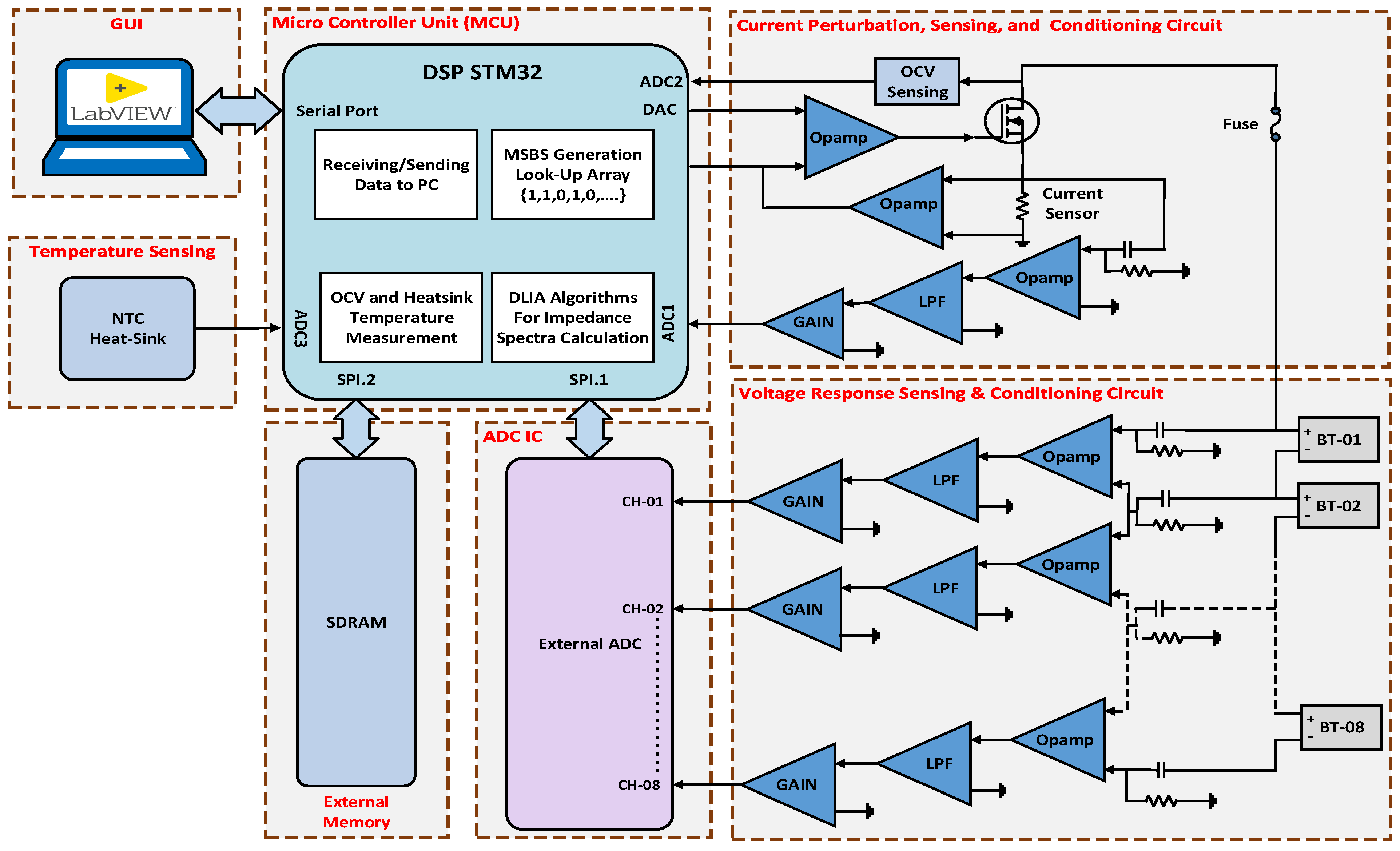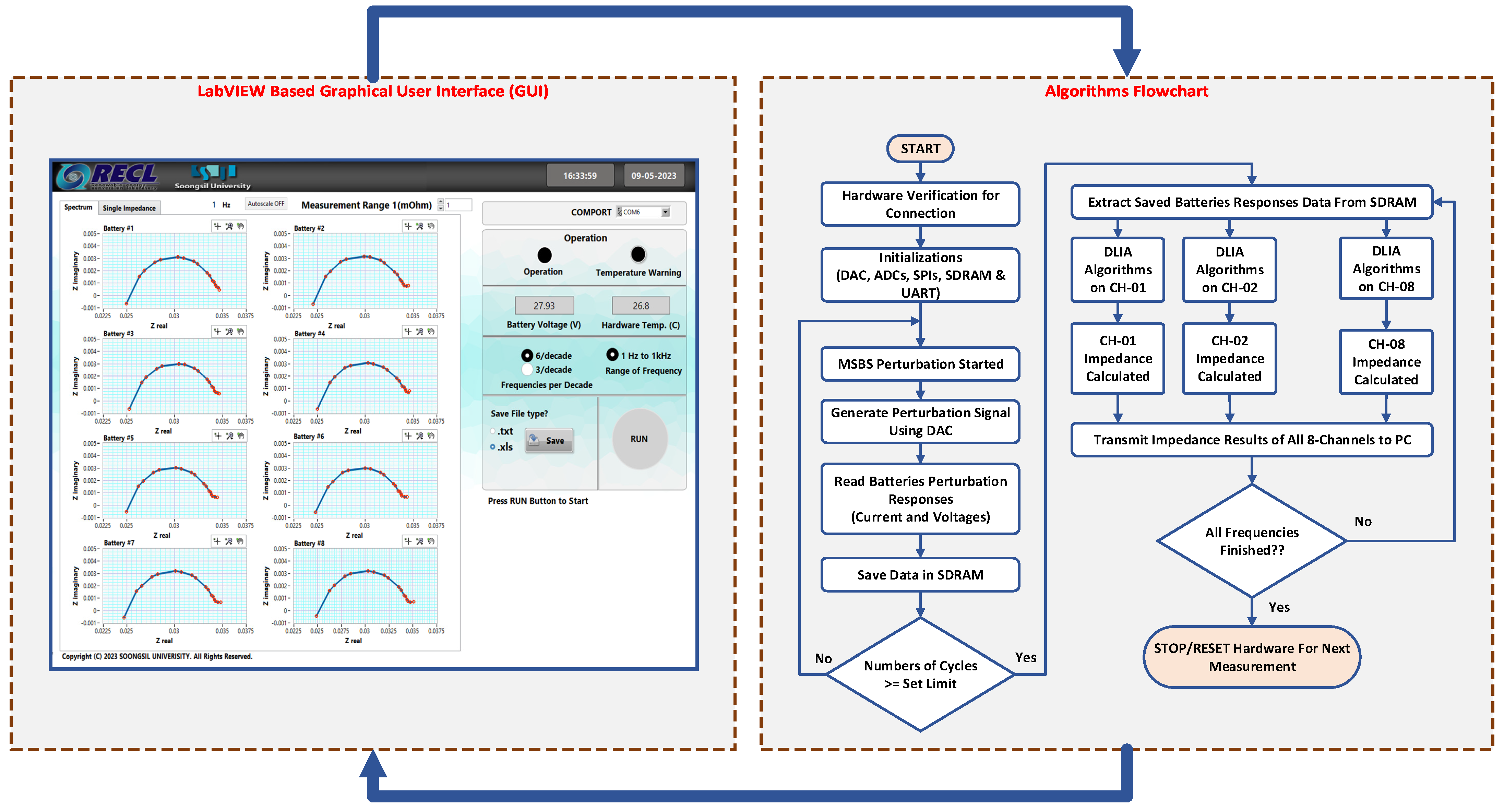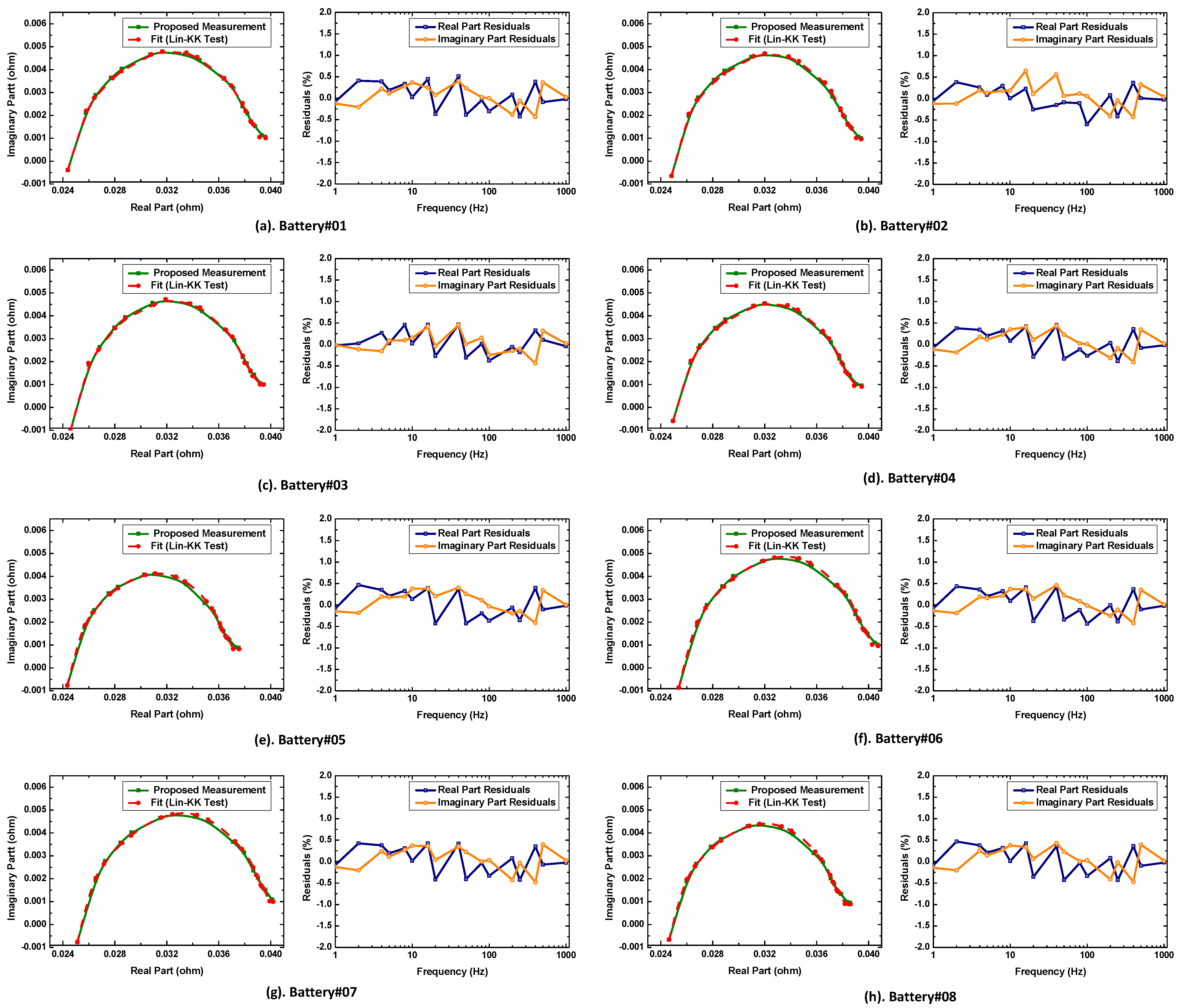A High-Speed Multichannel Electrochemical Impedance Spectroscopy System Using Broadband Multi-Sine Binary Perturbation for Retired Li-Ion Batteries of Electric Vehicles
Abstract
1. Introduction
2. Overview of Conventional EIS and Interpretation of Impedance Spectra
3. Broadband Excitations for EIS
3.1. CMSS
3.2. Combined Phased Multi-Sine Signal (CPMS)
3.3. MSBS
4. Architecture of the Presented High-Speed Multichannel EIS System
5. Experimental Validation and Discussion
5.1. Sinusoidal Sweep, CMSS, CPMS, and Presented MSBS Comparison
5.2. Validation of Presented Multichannel Fast EIS System Using Commercial EIS Instrument
5.3. Validation of Impedance Spectra Using KK Transform
5.4. Measurement Speed Comparison with Sinusoidal Sweep Perturbation
- Broadband MSBS perturbation is used instead of sinusoidal sweep excitation to shorten the measurement time.
- The 8-channel configuration is used, which further decreases the measurement time and increases the capability by simultaneously measuring the impedance spectra of eight individual batteries or modules with an overall voltage of less than 100 V.
6. Conclusions
Author Contributions
Funding
Data Availability Statement
Conflicts of Interest
References
- El Mejdoubi, A.; Chaoui, H.; Gualous, H.; Van Den Bossche, P.; Omar, N.; Van Mierlo, J. Lithium-Ion Batteries Health Prognosis Considering Aging Conditions. IEEE Trans. Power Electron. 2019, 34, 6834–6844. [Google Scholar] [CrossRef]
- Shi, Q.; Jiang, Z.; Wang, Z.; Shao, X.; He, L. State of Charge Estimation by Joint Approach with Model-Based and Data-Driven Algorithm for Lithium-Ion Battery. IEEE Trans. Instrum. Meas. 2022, 71, 3000610. [Google Scholar] [CrossRef]
- Afshari, S.S.; Cui, S.; Xu, X.; Liang, X. Remaining Useful Life Early Prediction of Batteries Based on the Differential Voltage and Differential Capacity Curves. IEEE Trans. Instrum. Meas. 2022, 71, 6500709. [Google Scholar] [CrossRef]
- Bamati, S.; Chaoui, H. Lithium-Ion Batteries Long Horizon Health Prognostic Using Machine Learning. IEEE Trans. Energy Convers. 2022, 37, 1176–1186. [Google Scholar] [CrossRef]
- Sanz-Gorrachategui, I.; Pastor-Flores, P.; Pajovic, M.; Wang, Y.; Orlik, P.V.; Bernal-Ruiz, C.; Bono-Nuez, A.; Artal-Sevil, J.S. Remaining Useful Life Estimation for LFP Cells in Second-Life Applications. IEEE Trans. Instrum. Meas. 2021, 70, 2505810. [Google Scholar] [CrossRef]
- Farmann, A.; Waag, W.; Marongiu, A.; Sauer, D.U. Critical review of on-board capacity estimation techniques for lithium-ion batteries in electric and hybrid electric vehicles. J. Power Sources 2015, 281, 114–130. [Google Scholar] [CrossRef]
- Xiong, R.; Zhang, Y.; Wang, J.; He, H.; Peng, S.; Pecht, M. Lithium-Ion Battery Health Prognosis Based on a Real Battery Management System Used in Electric Vehicles. IEEE Trans. Veh. Technol. 2019, 68, 4110–4121. [Google Scholar] [CrossRef]
- Liu, D.; Xie, W.; Liao, H.; Peng, Y. An Integrated Probabilistic Approach to Lithium-Ion Battery Remaining Useful Life Estimation. IEEE Trans. Instrum. Meas. 2015, 64, 660–670. [Google Scholar] [CrossRef]
- Vetter, J.; Novák, P.; Wagner, M.R.; Veit, C.; Möller, K.-C.; Besenhard, J.O.; Winter, M.; Wohlfahrt-Mehrens, M.; Vogler, C.; Hammouche, A. Ageing mechanisms in lithium-ion batteries. J. Power Sources 2005, 147, 269–281. [Google Scholar] [CrossRef]
- Gao, Y.; Zhang, X.; Guo, B.; Zhu, C.; Wiedemann, J.; Wang, L.; Cao, J. Health-Aware Multiobjective Optimal Charging Strategy with Coupled Electrochemical-Thermal-Aging Model for Lithium-Ion Battery. IEEE Trans. Ind. Inform. 2020, 16, 3417–3429. [Google Scholar] [CrossRef]
- Moura, S.J.; Stein, J.L.; Fathy, H.K. Battery-Health Conscious Power Management in Plug-In Hybrid Electric Vehicles via Electrochemical Modeling and Stochastic Control. IEEE Trans. Control. Syst. Technol. 2013, 21, 679–694. [Google Scholar] [CrossRef]
- Zhang, Q.; Huang, C.-G.; Li, H.; Feng, G.; Peng, W. Electrochemical Impedance Spectroscopy Based State-of-Health Estimation for Lithium-Ion Battery Considering Temperature and State-of-Charge Effect. IEEE Trans. Transp. Electrif. 2022, 8, 4633–4645. [Google Scholar] [CrossRef]
- Meddings, N.; Heinrich, M.; Overney, F.; Lee, J.-S.; Ruiz, V.; Napolitano, E.; Seitz, S.; Hinds, G.; Raccichini, R.; Gaberšček, M.; et al. Application of electrochemical impedance spectroscopy to commercial Li-ion cells: A review. J. Power Sources 2020, 480, 228742. [Google Scholar] [CrossRef]
- Fischer, A.; Kallel, A.Y.; Kanoun, O. Comparative Study of Excitation Signals for Microcontroller-based EIS Measurement on Li-Ion Batteries. In Proceedings of the 2021 International Workshop on Impedance Spectroscopy (IWIS), Chemnitz, Germany, 29 September–1 October 2021; pp. 44–47. [Google Scholar] [CrossRef]
- Xia, Z.; Qahouq, J.A.A. Evaluation of Parameter Variations of Equivalent Circuit Model of Lithium-ion Battery under Different SOH Conditions. In Proceedings of the 2020 IEEE Energy Conversion Congress and Exposition (ECCE), Detroit, MI, USA, 11–15 October 2020; pp. 1519–1523. [Google Scholar] [CrossRef]
- Skoog, S.; David, S. Parameterization of linear equivalent circuit models over wide temperature and SOC spans for automotive lithium-ion cells using electrochemical impedance spectroscopy. J. Energy Storage 2017, 14, 39–48. [Google Scholar] [CrossRef]
- Din, E.; Schaef, C.; Moffat, K.; Stauth, J.T. A Scalable Active Battery Management System with Embedded Real-Time Electrochemical Impedance Spectroscopy. IEEE Trans. Power Electron. 2017, 32, 5688–5698. [Google Scholar] [CrossRef]
- Richardson, R.R.; Ireland, P.T.; Howey, D.A. Battery internal temperature estimation by combined impedance and surface temperature measurement. J. Power Sources 2014, 265, 254–261. [Google Scholar] [CrossRef]
- Zappen, H.; Ringbeck, F.; Sauer, D. Application of Time-Resolved Multi-Sine Impedance Spectroscopy for Lithium-Ion Battery Characterization. Batteries 2018, 4, 64. [Google Scholar] [CrossRef]
- Sihvo, J.; Stroe, D.-I.; Messo, T.; Roinila, T. Fast Approach for Battery Impedance Identification Using Pseudo-Random Sequence Signals. IEEE Trans. Power Electron. 2020, 35, 2548–2557. [Google Scholar] [CrossRef]
- Kallel, A.Y.; Kanoun, O. A Crest-Factor Optimization Algorithm for Multisine Signals based on the Evolutionary Role Playing Game Theory. In Proceedings of the 2021 International Workshop on Impedance Spectroscopy (IWIS), Chemnitz, Germany, 29 September–1 October 2021; pp. 131–136. [Google Scholar] [CrossRef]
- Schroeder, M. Synthesis of low-peak-factor signals and binary sequences with low autocorrelation (Corresp.). IEEE Trans. Inf. Theory 1970, 16, 85–89. [Google Scholar] [CrossRef]
- Ojarand, J.; Min, M. Recent Advances in Crest Factor Minimization of Multisine. Elektron. Ir Elektrotechnika 2017, 23, 59–62. [Google Scholar] [CrossRef]
- Van Den Bos, A. A new method for synthesis of low-peak-factor signals. IEEE Trans. Acoust. Speech Signal Process. 1987, 35, 120–122. [Google Scholar] [CrossRef]
- Yang, Y.; Zhang, F.; Tao, K.; Sanchez, B.; Wen, H.; Teng, Z. An improved crest factor minimization algorithm to synthesize multisines with arbitrary spectrum. Physiol. Meas. 2015, 36, 895. [Google Scholar] [CrossRef] [PubMed]
- Van der Ouderaa, E.; Schoukens, J.; Renneboog, J. Peak factor minimization of input and output signals of linear systems. IEEE Trans. Instrum. Meas. 1988, 37, 207–212. [Google Scholar] [CrossRef]
- Sihvo, J.; Messo, T.; Roinila, T.; Luhtala, R.; Stroe, D.I. Online identification of internal impedance of Li-ion battery cell using ternary-sequence injection. In Proceedings of the 2018 IEEE Energy Conversion Congress and Exposition (ECCE), Portland, OR, USA, 23–27 September 2018; pp. 2705–2711. [Google Scholar] [CrossRef]
- Roinila, T.; Messo, T. Online Grid-Impedance Measurement Using Ternary-Sequence Injection. IEEE Trans. Ind. Appl. 2018, 54, 5097–5103. [Google Scholar] [CrossRef]
- Talat, M.T.; Khawaja, A.H. Li-Ion Battery Parameter Identification Using Pseudo Random Noise. In Proceedings of the 2019 15th International Conference on Emerging Technologies (ICET), Peshawar, Pakistan, 2–3 December 2019; pp. 1–5. [Google Scholar] [CrossRef]
- Schönleber, M.; Klotz, D.; Ivers-Tiffée, E. A Method for Improving the Robustness of linear Kramers-Kronig Validity Tests. Electrochim. Acta 2014, 131, 20–27. [Google Scholar] [CrossRef]
- Al Nazer, R.; Cattin, V.; Granjon, P.; Montaru, M.; Ranieri, M. Broadband Identification of Battery Electrical Impedance for HEVs. IEEE Trans. Veh. Technol. 2013, 62, 2896–2905. [Google Scholar] [CrossRef]
- Barsoukov, E.; Macdonald, J.R. Impedance Spectroscopy: Theory, Experiment, and Applications, 2nd ed.; John Wiley & Sons: Hoboken, NJ, USA, 2005; ISBN 0-471-64749-7. [Google Scholar]
- Koch, R.; Jossen, A.; Kanoun. On-line Electrochemical Impedance Spectroscopy for Lithium-Ion Battery Systems; Universitätsbibliothek der TU München: München, Germany, 2017. [Google Scholar]
- Available online: https://www.brs-messtechnik.de/produktuebersicht-de (accessed on 3 April 2024).
- Karlsruhe Institute of Technology. Lin-KK Software Tool. Available online: https://www.iam.kit.edu/et/english/Lin-KK.php (accessed on 12 December 2023).










| Battery Model | Nominal Voltage | OCV | Capacity |
|---|---|---|---|
| Samsung INR18650-29E | 3.65 V | 3.50 | 2.850 Ah |
| Parameter | Sinusoidal Sweep | CMSS | CPMS | MSBS |
|---|---|---|---|---|
| Frequency range | 1 Hz to 1 kHz | |||
| Sampling frequency | 40 kHz | |||
| Frequency components | 17 | 17 | 500 | 17 |
| Frequency distribution | random | random | linear | random |
| Pk to Pk Current | 1.0 A | |||
| Perturbation time | 60.0 s | 5.0 s | 5.0 s | 5.0 s |
| Method | CMSS | CPMS | MSBS |
|---|---|---|---|
| RMSE % | 7.68% | 24.53% | 0.51% |
| S. No | R−Chi Squared | Chi-Squared Error (%) |
|---|---|---|
| Battery-01 | 3.28 × 10−5 | 0.572 |
| Battery-02 | 3.54 × 10−5 | 0.594 |
| Battery-03 | 3.78 × 10−5 | 0.641 |
| Battery-04 | 3.94 × 10−5 | 0.628 |
| Battery-05 | 3.18 × 10−5 | 0.563 |
| Battery-06 | 3.09 × 10−5 | 0.556 |
| Battery-07 | 3.32 × 10−5 | 0.576 |
| Battery-08 | 3.41 × 10−5 | 0.583 |
| Parameter | Conventional EIS | Developed High-Speed Multichannel EIS System |
|---|---|---|
| Perturbation type | Sinusoidal Sweep | MSBS |
| Frequency range | 1 Hz to 1 kHz | 1 Hz to 1 kHz |
| Frequency components | 17 | 17 |
| Measurement Time | ||
| Single Battery | 34.0 s | 5.0 s |
| Eight (8) Batteries | 272.0 s | 5.0 s |
Disclaimer/Publisher’s Note: The statements, opinions and data contained in all publications are solely those of the individual author(s) and contributor(s) and not of MDPI and/or the editor(s). MDPI and/or the editor(s) disclaim responsibility for any injury to people or property resulting from any ideas, methods, instructions or products referred to in the content. |
© 2024 by the authors. Licensee MDPI, Basel, Switzerland. This article is an open access article distributed under the terms and conditions of the Creative Commons Attribution (CC BY) license (https://creativecommons.org/licenses/by/4.0/).
Share and Cite
Sheraz, M.; Choi, W. A High-Speed Multichannel Electrochemical Impedance Spectroscopy System Using Broadband Multi-Sine Binary Perturbation for Retired Li-Ion Batteries of Electric Vehicles. Energies 2024, 17, 2979. https://doi.org/10.3390/en17122979
Sheraz M, Choi W. A High-Speed Multichannel Electrochemical Impedance Spectroscopy System Using Broadband Multi-Sine Binary Perturbation for Retired Li-Ion Batteries of Electric Vehicles. Energies. 2024; 17(12):2979. https://doi.org/10.3390/en17122979
Chicago/Turabian StyleSheraz, Muhammad, and Woojin Choi. 2024. "A High-Speed Multichannel Electrochemical Impedance Spectroscopy System Using Broadband Multi-Sine Binary Perturbation for Retired Li-Ion Batteries of Electric Vehicles" Energies 17, no. 12: 2979. https://doi.org/10.3390/en17122979
APA StyleSheraz, M., & Choi, W. (2024). A High-Speed Multichannel Electrochemical Impedance Spectroscopy System Using Broadband Multi-Sine Binary Perturbation for Retired Li-Ion Batteries of Electric Vehicles. Energies, 17(12), 2979. https://doi.org/10.3390/en17122979








